Comprehensive Analysis of Leadership and Management at Uber
VerifiedAdded on 2020/10/05
|13
|4071
|255
Report
AI Summary
This report provides a comprehensive analysis of leadership and management practices within Uber, a prominent US-based ride-sharing company. It explores the roles and characteristics of leaders and managers, highlighting their contributions to achieving business objectives. The report delves into the application of leadership and management functions within Uber, including planning, organizing, commanding, controlling, and coordinating. Furthermore, it examines various leadership theories, such as contingency leadership, situational leadership, and system leadership, and how they are applied to address different situations and challenges within the company. The report also discusses the impact of the business environment on operational management and decision-making processes. Overall, this report offers valuable insights into the leadership and management strategies employed by Uber to drive its success in the transportation industry.

MANAGEMENT
AND OPERATIONS
AND OPERATIONS
Paraphrase This Document
Need a fresh take? Get an instant paraphrase of this document with our AI Paraphraser
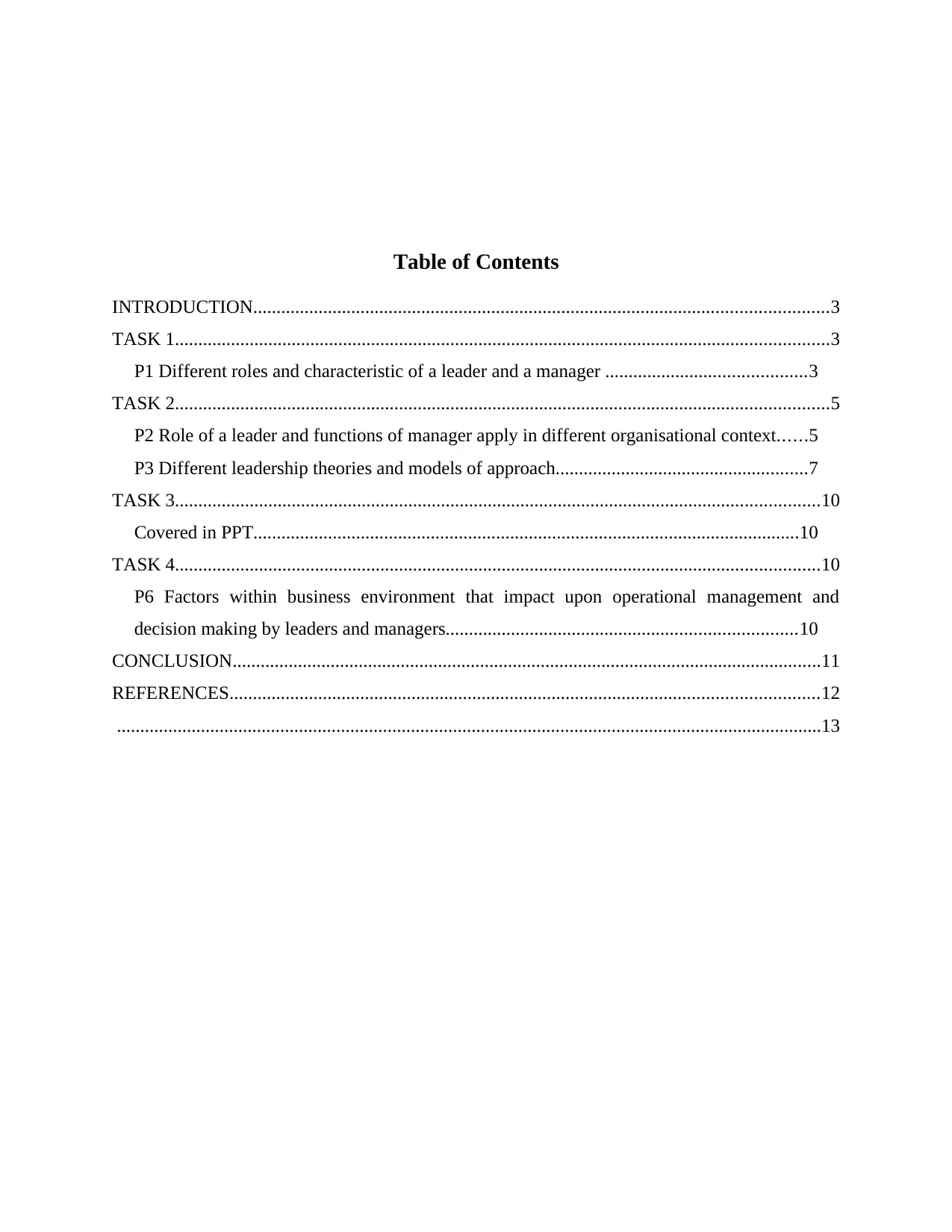
Table of Contents
INTRODUCTION...........................................................................................................................3
TASK 1............................................................................................................................................3
P1 Different roles and characteristic of a leader and a manager ...........................................3
TASK 2............................................................................................................................................5
P2 Role of a leader and functions of manager apply in different organisational context......5
P3 Different leadership theories and models of approach......................................................7
TASK 3..........................................................................................................................................10
Covered in PPT.....................................................................................................................10
TASK 4..........................................................................................................................................10
P6 Factors within business environment that impact upon operational management and
decision making by leaders and managers...........................................................................10
CONCLUSION..............................................................................................................................11
REFERENCES..............................................................................................................................12
.......................................................................................................................................................13
INTRODUCTION...........................................................................................................................3
TASK 1............................................................................................................................................3
P1 Different roles and characteristic of a leader and a manager ...........................................3
TASK 2............................................................................................................................................5
P2 Role of a leader and functions of manager apply in different organisational context......5
P3 Different leadership theories and models of approach......................................................7
TASK 3..........................................................................................................................................10
Covered in PPT.....................................................................................................................10
TASK 4..........................................................................................................................................10
P6 Factors within business environment that impact upon operational management and
decision making by leaders and managers...........................................................................10
CONCLUSION..............................................................................................................................11
REFERENCES..............................................................................................................................12
.......................................................................................................................................................13
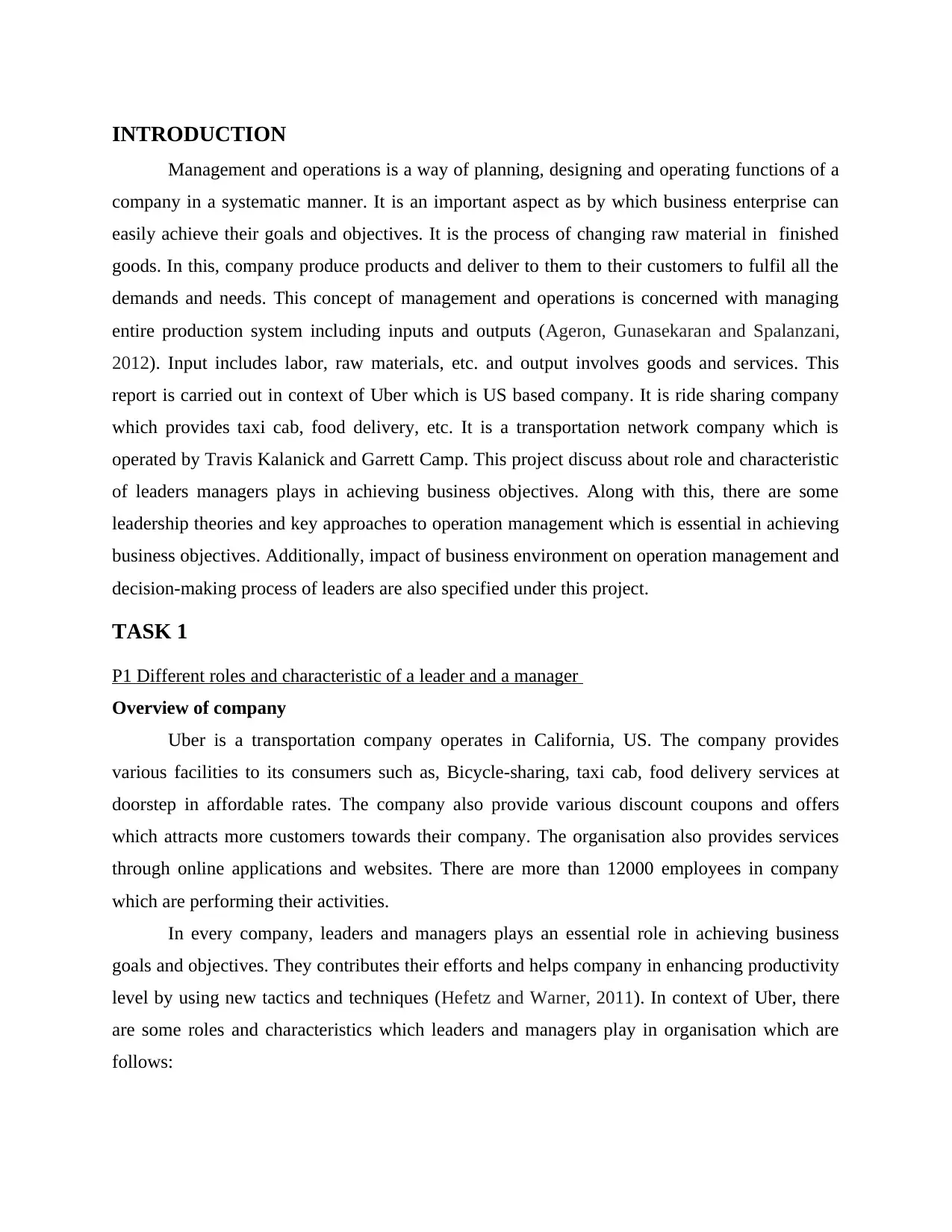
INTRODUCTION
Management and operations is a way of planning, designing and operating functions of a
company in a systematic manner. It is an important aspect as by which business enterprise can
easily achieve their goals and objectives. It is the process of changing raw material in finished
goods. In this, company produce products and deliver to them to their customers to fulfil all the
demands and needs. This concept of management and operations is concerned with managing
entire production system including inputs and outputs (Ageron, Gunasekaran and Spalanzani,
2012). Input includes labor, raw materials, etc. and output involves goods and services. This
report is carried out in context of Uber which is US based company. It is ride sharing company
which provides taxi cab, food delivery, etc. It is a transportation network company which is
operated by Travis Kalanick and Garrett Camp. This project discuss about role and characteristic
of leaders managers plays in achieving business objectives. Along with this, there are some
leadership theories and key approaches to operation management which is essential in achieving
business objectives. Additionally, impact of business environment on operation management and
decision-making process of leaders are also specified under this project.
TASK 1
P1 Different roles and characteristic of a leader and a manager
Overview of company
Uber is a transportation company operates in California, US. The company provides
various facilities to its consumers such as, Bicycle-sharing, taxi cab, food delivery services at
doorstep in affordable rates. The company also provide various discount coupons and offers
which attracts more customers towards their company. The organisation also provides services
through online applications and websites. There are more than 12000 employees in company
which are performing their activities.
In every company, leaders and managers plays an essential role in achieving business
goals and objectives. They contributes their efforts and helps company in enhancing productivity
level by using new tactics and techniques (Hefetz and Warner, 2011). In context of Uber, there
are some roles and characteristics which leaders and managers play in organisation which are
follows:
Management and operations is a way of planning, designing and operating functions of a
company in a systematic manner. It is an important aspect as by which business enterprise can
easily achieve their goals and objectives. It is the process of changing raw material in finished
goods. In this, company produce products and deliver to them to their customers to fulfil all the
demands and needs. This concept of management and operations is concerned with managing
entire production system including inputs and outputs (Ageron, Gunasekaran and Spalanzani,
2012). Input includes labor, raw materials, etc. and output involves goods and services. This
report is carried out in context of Uber which is US based company. It is ride sharing company
which provides taxi cab, food delivery, etc. It is a transportation network company which is
operated by Travis Kalanick and Garrett Camp. This project discuss about role and characteristic
of leaders managers plays in achieving business objectives. Along with this, there are some
leadership theories and key approaches to operation management which is essential in achieving
business objectives. Additionally, impact of business environment on operation management and
decision-making process of leaders are also specified under this project.
TASK 1
P1 Different roles and characteristic of a leader and a manager
Overview of company
Uber is a transportation company operates in California, US. The company provides
various facilities to its consumers such as, Bicycle-sharing, taxi cab, food delivery services at
doorstep in affordable rates. The company also provide various discount coupons and offers
which attracts more customers towards their company. The organisation also provides services
through online applications and websites. There are more than 12000 employees in company
which are performing their activities.
In every company, leaders and managers plays an essential role in achieving business
goals and objectives. They contributes their efforts and helps company in enhancing productivity
level by using new tactics and techniques (Hefetz and Warner, 2011). In context of Uber, there
are some roles and characteristics which leaders and managers play in organisation which are
follows:
⊘ This is a preview!⊘
Do you want full access?
Subscribe today to unlock all pages.

Trusted by 1+ million students worldwide

Leader: A leader is an individual who maximise efforts of staff members by motivating them
towards their achievement. In Uber, the leader of company encourage and support their
employees so that they can perform their activities in a well and effective manner.
Managers: A manager is an individual who have abilities to motivate, communicate and inspire
people to take productive actions. In Uber, the manager of company provides training session to
their staff members so that they can resolve their issues easily and quickly.
Role of a leader
Create visions: The first important role which leader play is creating clear vision. They
define clear visions to their employees and monitor if their activities are on track on not.
They also develops strategies and tactics so to achieve their desired ambitions (Aki,
Wakui and Yokoyama, 2016). In Uber, the leaders plays a vital role in creating
organisational visions which helps them to accomplish their strategies in allotted time
frame.
Representative of organisation: Leaders are also known as representative of company
because they represents themselves at seminars, conferences and business meetings. The
leader of Uber also communicates with internal staff and outsiders to promote their
company and increase sales (Zhao, Zhang and Sun, 2016).
Characteristics of a leader
Motivation: The most essential quality and characteristic of a leader is motivation. They
motivate its employees towards achievement of their goals by doing work hard and
contributes their efforts. The leader of Uber also guides and motivates staff members to
attain goals an targets.
Clear understanding of individual responsibilities: The leaders of company also know
what type of a responsibility they have to delegate to employees and which members can
give their best in different job profiles. In context of Uber, the leader delegates roles and
responsibilities to their employees according to their qualification and skills.
Role of a manager
Decisional roles: The initial and important role which manager plays is decision making.
They make decisions regarding their team management and projects assignments (Jang,
Lee and Noh, 2012). They decide which employee is best suited and can submitted its
towards their achievement. In Uber, the leader of company encourage and support their
employees so that they can perform their activities in a well and effective manner.
Managers: A manager is an individual who have abilities to motivate, communicate and inspire
people to take productive actions. In Uber, the manager of company provides training session to
their staff members so that they can resolve their issues easily and quickly.
Role of a leader
Create visions: The first important role which leader play is creating clear vision. They
define clear visions to their employees and monitor if their activities are on track on not.
They also develops strategies and tactics so to achieve their desired ambitions (Aki,
Wakui and Yokoyama, 2016). In Uber, the leaders plays a vital role in creating
organisational visions which helps them to accomplish their strategies in allotted time
frame.
Representative of organisation: Leaders are also known as representative of company
because they represents themselves at seminars, conferences and business meetings. The
leader of Uber also communicates with internal staff and outsiders to promote their
company and increase sales (Zhao, Zhang and Sun, 2016).
Characteristics of a leader
Motivation: The most essential quality and characteristic of a leader is motivation. They
motivate its employees towards achievement of their goals by doing work hard and
contributes their efforts. The leader of Uber also guides and motivates staff members to
attain goals an targets.
Clear understanding of individual responsibilities: The leaders of company also know
what type of a responsibility they have to delegate to employees and which members can
give their best in different job profiles. In context of Uber, the leader delegates roles and
responsibilities to their employees according to their qualification and skills.
Role of a manager
Decisional roles: The initial and important role which manager plays is decision making.
They make decisions regarding their team management and projects assignments (Jang,
Lee and Noh, 2012). They decide which employee is best suited and can submitted its
Paraphrase This Document
Need a fresh take? Get an instant paraphrase of this document with our AI Paraphraser
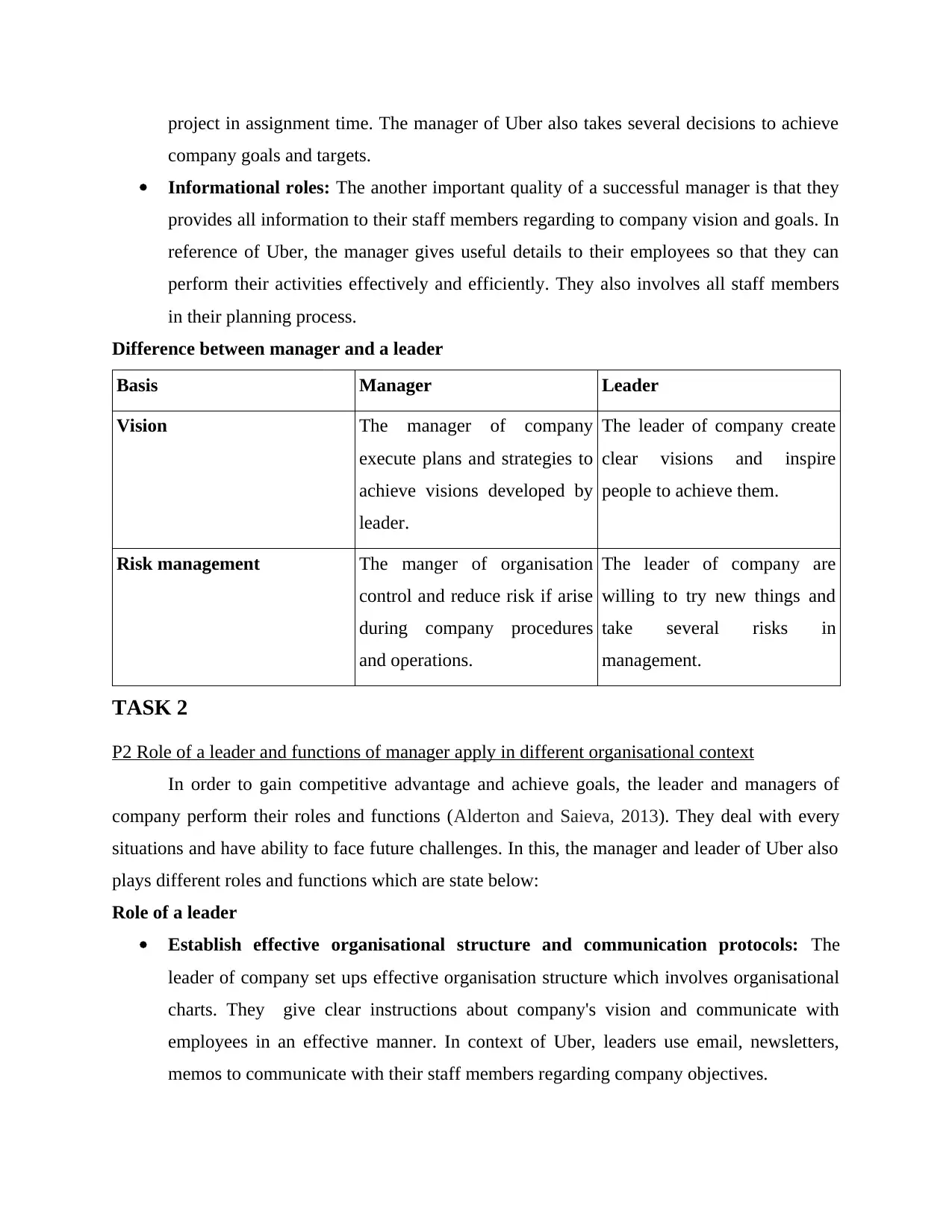
project in assignment time. The manager of Uber also takes several decisions to achieve
company goals and targets.
Informational roles: The another important quality of a successful manager is that they
provides all information to their staff members regarding to company vision and goals. In
reference of Uber, the manager gives useful details to their employees so that they can
perform their activities effectively and efficiently. They also involves all staff members
in their planning process.
Difference between manager and a leader
Basis Manager Leader
Vision The manager of company
execute plans and strategies to
achieve visions developed by
leader.
The leader of company create
clear visions and inspire
people to achieve them.
Risk management The manger of organisation
control and reduce risk if arise
during company procedures
and operations.
The leader of company are
willing to try new things and
take several risks in
management.
TASK 2
P2 Role of a leader and functions of manager apply in different organisational context
In order to gain competitive advantage and achieve goals, the leader and managers of
company perform their roles and functions (Alderton and Saieva, 2013). They deal with every
situations and have ability to face future challenges. In this, the manager and leader of Uber also
plays different roles and functions which are state below:
Role of a leader
Establish effective organisational structure and communication protocols: The
leader of company set ups effective organisation structure which involves organisational
charts. They give clear instructions about company's vision and communicate with
employees in an effective manner. In context of Uber, leaders use email, newsletters,
memos to communicate with their staff members regarding company objectives.
company goals and targets.
Informational roles: The another important quality of a successful manager is that they
provides all information to their staff members regarding to company vision and goals. In
reference of Uber, the manager gives useful details to their employees so that they can
perform their activities effectively and efficiently. They also involves all staff members
in their planning process.
Difference between manager and a leader
Basis Manager Leader
Vision The manager of company
execute plans and strategies to
achieve visions developed by
leader.
The leader of company create
clear visions and inspire
people to achieve them.
Risk management The manger of organisation
control and reduce risk if arise
during company procedures
and operations.
The leader of company are
willing to try new things and
take several risks in
management.
TASK 2
P2 Role of a leader and functions of manager apply in different organisational context
In order to gain competitive advantage and achieve goals, the leader and managers of
company perform their roles and functions (Alderton and Saieva, 2013). They deal with every
situations and have ability to face future challenges. In this, the manager and leader of Uber also
plays different roles and functions which are state below:
Role of a leader
Establish effective organisational structure and communication protocols: The
leader of company set ups effective organisation structure which involves organisational
charts. They give clear instructions about company's vision and communicate with
employees in an effective manner. In context of Uber, leaders use email, newsletters,
memos to communicate with their staff members regarding company objectives.
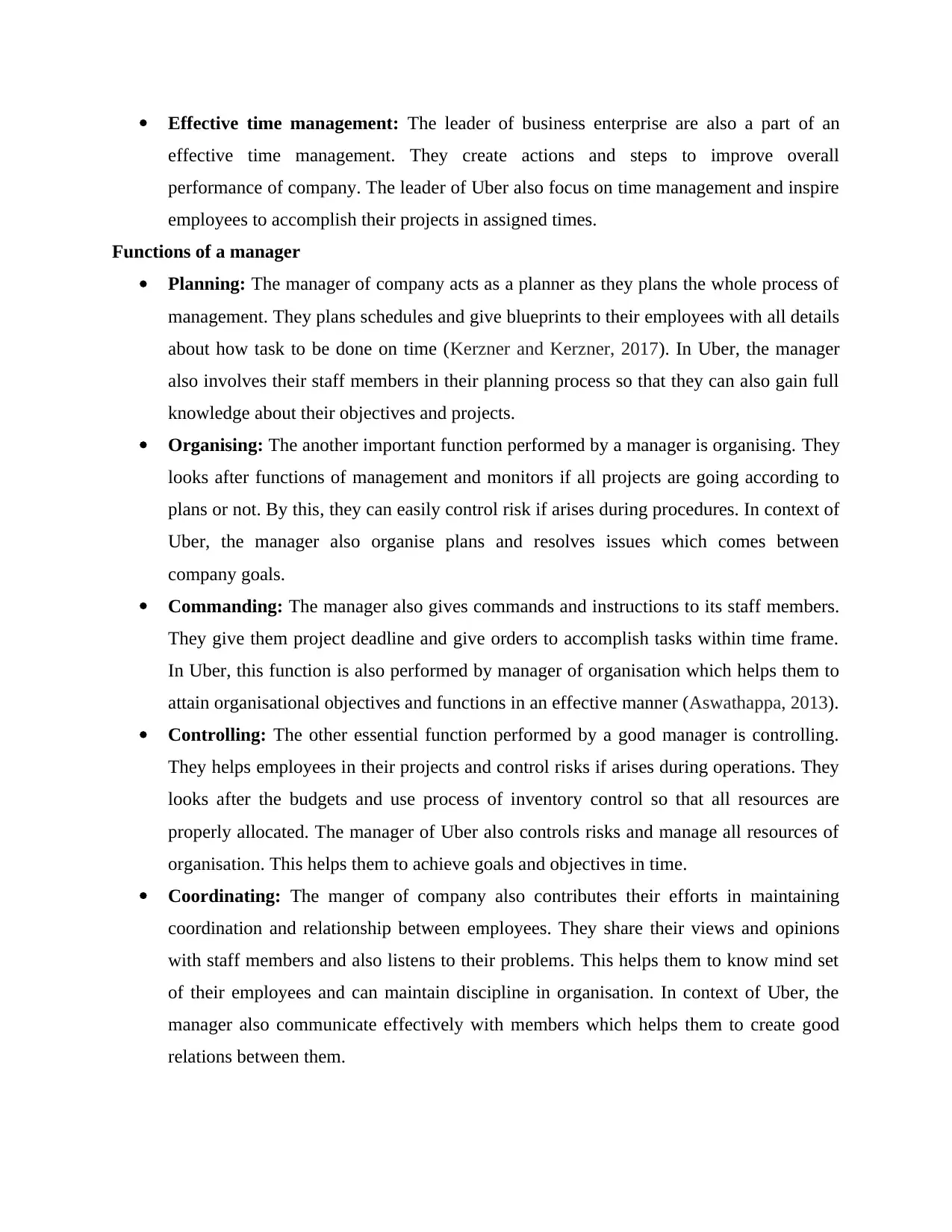
Effective time management: The leader of business enterprise are also a part of an
effective time management. They create actions and steps to improve overall
performance of company. The leader of Uber also focus on time management and inspire
employees to accomplish their projects in assigned times.
Functions of a manager
Planning: The manager of company acts as a planner as they plans the whole process of
management. They plans schedules and give blueprints to their employees with all details
about how task to be done on time (Kerzner and Kerzner, 2017). In Uber, the manager
also involves their staff members in their planning process so that they can also gain full
knowledge about their objectives and projects.
Organising: The another important function performed by a manager is organising. They
looks after functions of management and monitors if all projects are going according to
plans or not. By this, they can easily control risk if arises during procedures. In context of
Uber, the manager also organise plans and resolves issues which comes between
company goals.
Commanding: The manager also gives commands and instructions to its staff members.
They give them project deadline and give orders to accomplish tasks within time frame.
In Uber, this function is also performed by manager of organisation which helps them to
attain organisational objectives and functions in an effective manner (Aswathappa, 2013).
Controlling: The other essential function performed by a good manager is controlling.
They helps employees in their projects and control risks if arises during operations. They
looks after the budgets and use process of inventory control so that all resources are
properly allocated. The manager of Uber also controls risks and manage all resources of
organisation. This helps them to achieve goals and objectives in time.
Coordinating: The manger of company also contributes their efforts in maintaining
coordination and relationship between employees. They share their views and opinions
with staff members and also listens to their problems. This helps them to know mind set
of their employees and can maintain discipline in organisation. In context of Uber, the
manager also communicate effectively with members which helps them to create good
relations between them.
effective time management. They create actions and steps to improve overall
performance of company. The leader of Uber also focus on time management and inspire
employees to accomplish their projects in assigned times.
Functions of a manager
Planning: The manager of company acts as a planner as they plans the whole process of
management. They plans schedules and give blueprints to their employees with all details
about how task to be done on time (Kerzner and Kerzner, 2017). In Uber, the manager
also involves their staff members in their planning process so that they can also gain full
knowledge about their objectives and projects.
Organising: The another important function performed by a manager is organising. They
looks after functions of management and monitors if all projects are going according to
plans or not. By this, they can easily control risk if arises during procedures. In context of
Uber, the manager also organise plans and resolves issues which comes between
company goals.
Commanding: The manager also gives commands and instructions to its staff members.
They give them project deadline and give orders to accomplish tasks within time frame.
In Uber, this function is also performed by manager of organisation which helps them to
attain organisational objectives and functions in an effective manner (Aswathappa, 2013).
Controlling: The other essential function performed by a good manager is controlling.
They helps employees in their projects and control risks if arises during operations. They
looks after the budgets and use process of inventory control so that all resources are
properly allocated. The manager of Uber also controls risks and manage all resources of
organisation. This helps them to achieve goals and objectives in time.
Coordinating: The manger of company also contributes their efforts in maintaining
coordination and relationship between employees. They share their views and opinions
with staff members and also listens to their problems. This helps them to know mind set
of their employees and can maintain discipline in organisation. In context of Uber, the
manager also communicate effectively with members which helps them to create good
relations between them.
⊘ This is a preview!⊘
Do you want full access?
Subscribe today to unlock all pages.

Trusted by 1+ million students worldwide
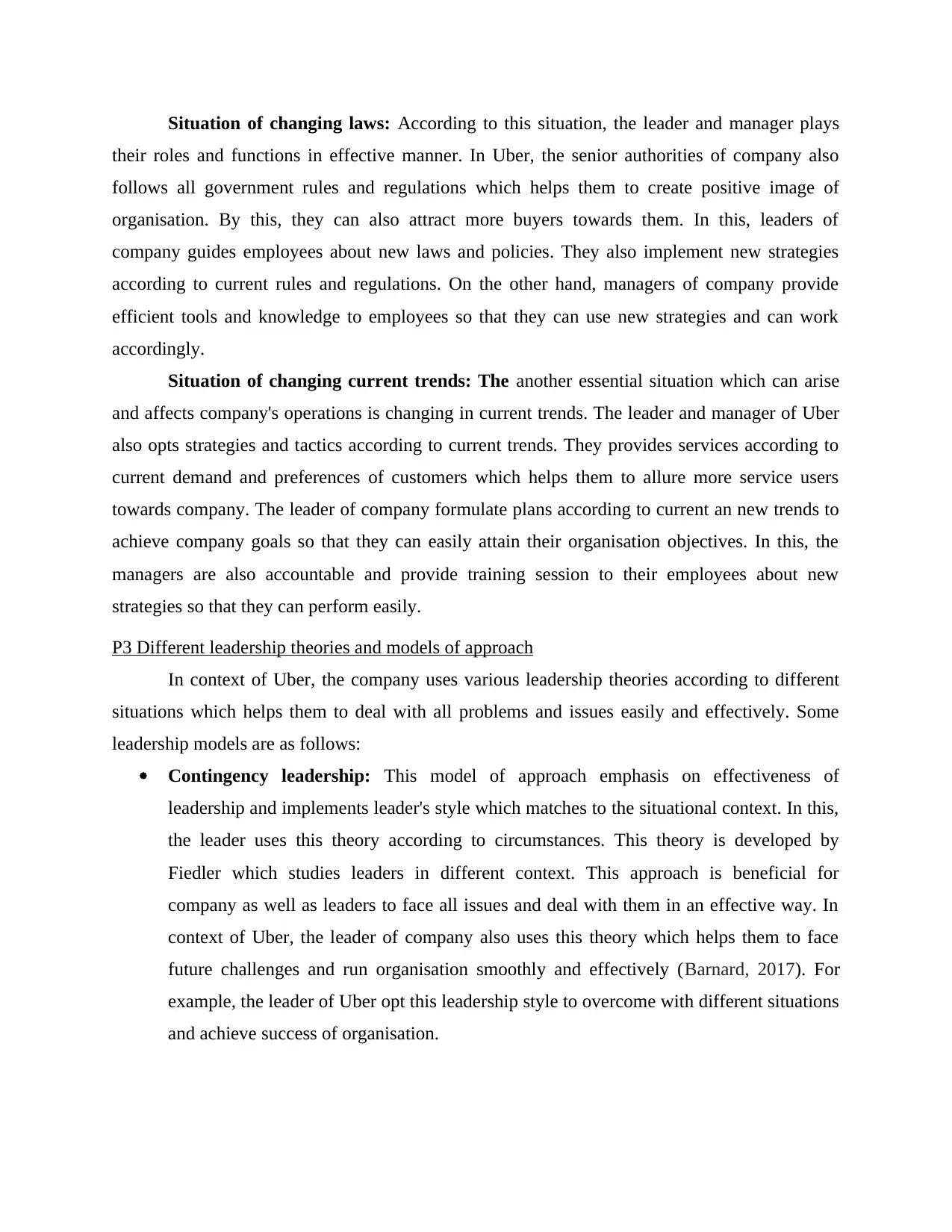
Situation of changing laws: According to this situation, the leader and manager plays
their roles and functions in effective manner. In Uber, the senior authorities of company also
follows all government rules and regulations which helps them to create positive image of
organisation. By this, they can also attract more buyers towards them. In this, leaders of
company guides employees about new laws and policies. They also implement new strategies
according to current rules and regulations. On the other hand, managers of company provide
efficient tools and knowledge to employees so that they can use new strategies and can work
accordingly.
Situation of changing current trends: The another essential situation which can arise
and affects company's operations is changing in current trends. The leader and manager of Uber
also opts strategies and tactics according to current trends. They provides services according to
current demand and preferences of customers which helps them to allure more service users
towards company. The leader of company formulate plans according to current an new trends to
achieve company goals so that they can easily attain their organisation objectives. In this, the
managers are also accountable and provide training session to their employees about new
strategies so that they can perform easily.
P3 Different leadership theories and models of approach
In context of Uber, the company uses various leadership theories according to different
situations which helps them to deal with all problems and issues easily and effectively. Some
leadership models are as follows:
Contingency leadership: This model of approach emphasis on effectiveness of
leadership and implements leader's style which matches to the situational context. In this,
the leader uses this theory according to circumstances. This theory is developed by
Fiedler which studies leaders in different context. This approach is beneficial for
company as well as leaders to face all issues and deal with them in an effective way. In
context of Uber, the leader of company also uses this theory which helps them to face
future challenges and run organisation smoothly and effectively (Barnard, 2017). For
example, the leader of Uber opt this leadership style to overcome with different situations
and achieve success of organisation.
their roles and functions in effective manner. In Uber, the senior authorities of company also
follows all government rules and regulations which helps them to create positive image of
organisation. By this, they can also attract more buyers towards them. In this, leaders of
company guides employees about new laws and policies. They also implement new strategies
according to current rules and regulations. On the other hand, managers of company provide
efficient tools and knowledge to employees so that they can use new strategies and can work
accordingly.
Situation of changing current trends: The another essential situation which can arise
and affects company's operations is changing in current trends. The leader and manager of Uber
also opts strategies and tactics according to current trends. They provides services according to
current demand and preferences of customers which helps them to allure more service users
towards company. The leader of company formulate plans according to current an new trends to
achieve company goals so that they can easily attain their organisation objectives. In this, the
managers are also accountable and provide training session to their employees about new
strategies so that they can perform easily.
P3 Different leadership theories and models of approach
In context of Uber, the company uses various leadership theories according to different
situations which helps them to deal with all problems and issues easily and effectively. Some
leadership models are as follows:
Contingency leadership: This model of approach emphasis on effectiveness of
leadership and implements leader's style which matches to the situational context. In this,
the leader uses this theory according to circumstances. This theory is developed by
Fiedler which studies leaders in different context. This approach is beneficial for
company as well as leaders to face all issues and deal with them in an effective way. In
context of Uber, the leader of company also uses this theory which helps them to face
future challenges and run organisation smoothly and effectively (Barnard, 2017). For
example, the leader of Uber opt this leadership style to overcome with different situations
and achieve success of organisation.
Paraphrase This Document
Need a fresh take? Get an instant paraphrase of this document with our AI Paraphraser

Strength: In the senior authority of organisation focus on employees opinion regarding
management with helps them to maintain relationship with workers. The management style is
flexible in this type of approach.
Weakness: Contingency theory is complex in nature as empirical testing is difficult due to
involvement of many factors.
Situational leadership: According to this leadership style, the leader of company uses
this approach which helps them to resolve all problems and issues which arises in their
performance or operations. By this, they can easily attain and accomplish goals in time
frame. This model of approach is given by Paul Hersey and Ken Blanchard. In this,
author categorised leadership style into four different categories which are directing,
coaching, supporting and delegating. This helps them to manage all working and
functions properly.
Strength: The theory empowers employees as they are accountable for their own actions and
decisions. In this, authority gives liberty to their workers in finishing their undertakings
according to them.
Weakness: This theory is implemented and useful only in specific situations and issues. It is not
considered in normal day course or problems.
System leadership: According to this style, the leader of business enterprise create
situations and conditions in front of employees to monitor how they act and take steps to
overcome with them (Liang, Guo and Fung, 2015). This aid leaders to determine
capabilities, skills and behaviour of their employees. The leaders of Uber also considers
this approach which helps them to identify level of performance of their staff members.
This leadership styles also facilitates them to improve overall execution of management.
Strength: This theory is adaptive and dynamic in nature. It also help in increasing organisational
adaptability and focus on achieving individual as well as overall organisational goals.
Weakness: In this, decision making is delay and is not always practical. It is not useful to small
size organisations.
Classical theory of management: This theory is also known as 'scientific theory of
management'. This theory is developed by Frederick Taylor which emphasis on increasing level
of productivity of workers. In this, managers of Uber plays an essential role in attaining company
goals and objectives. According to this theory, the manager of company provides sufficient
management with helps them to maintain relationship with workers. The management style is
flexible in this type of approach.
Weakness: Contingency theory is complex in nature as empirical testing is difficult due to
involvement of many factors.
Situational leadership: According to this leadership style, the leader of company uses
this approach which helps them to resolve all problems and issues which arises in their
performance or operations. By this, they can easily attain and accomplish goals in time
frame. This model of approach is given by Paul Hersey and Ken Blanchard. In this,
author categorised leadership style into four different categories which are directing,
coaching, supporting and delegating. This helps them to manage all working and
functions properly.
Strength: The theory empowers employees as they are accountable for their own actions and
decisions. In this, authority gives liberty to their workers in finishing their undertakings
according to them.
Weakness: This theory is implemented and useful only in specific situations and issues. It is not
considered in normal day course or problems.
System leadership: According to this style, the leader of business enterprise create
situations and conditions in front of employees to monitor how they act and take steps to
overcome with them (Liang, Guo and Fung, 2015). This aid leaders to determine
capabilities, skills and behaviour of their employees. The leaders of Uber also considers
this approach which helps them to identify level of performance of their staff members.
This leadership styles also facilitates them to improve overall execution of management.
Strength: This theory is adaptive and dynamic in nature. It also help in increasing organisational
adaptability and focus on achieving individual as well as overall organisational goals.
Weakness: In this, decision making is delay and is not always practical. It is not useful to small
size organisations.
Classical theory of management: This theory is also known as 'scientific theory of
management'. This theory is developed by Frederick Taylor which emphasis on increasing level
of productivity of workers. In this, managers of Uber plays an essential role in attaining company
goals and objectives. According to this theory, the manager of company provides sufficient
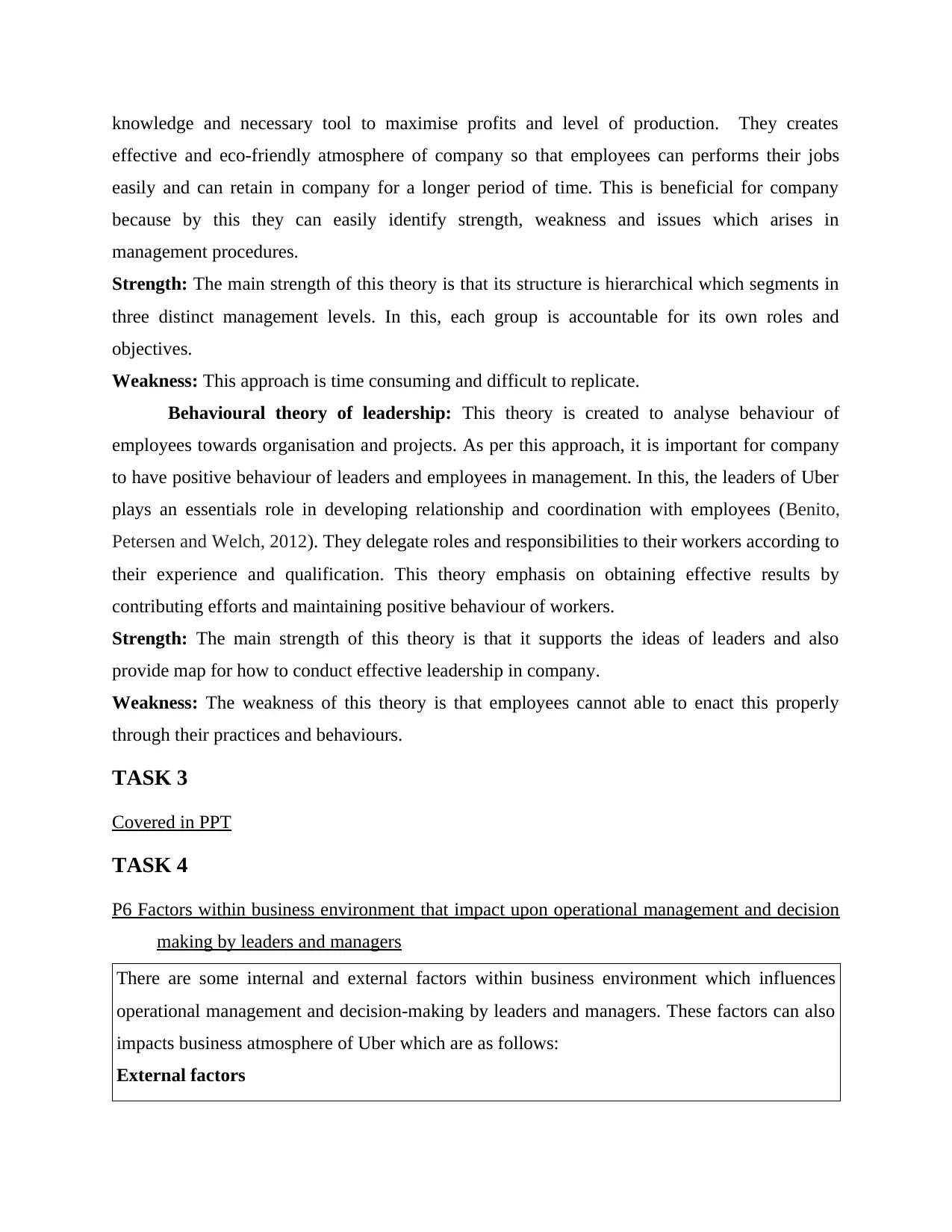
knowledge and necessary tool to maximise profits and level of production. They creates
effective and eco-friendly atmosphere of company so that employees can performs their jobs
easily and can retain in company for a longer period of time. This is beneficial for company
because by this they can easily identify strength, weakness and issues which arises in
management procedures.
Strength: The main strength of this theory is that its structure is hierarchical which segments in
three distinct management levels. In this, each group is accountable for its own roles and
objectives.
Weakness: This approach is time consuming and difficult to replicate.
Behavioural theory of leadership: This theory is created to analyse behaviour of
employees towards organisation and projects. As per this approach, it is important for company
to have positive behaviour of leaders and employees in management. In this, the leaders of Uber
plays an essentials role in developing relationship and coordination with employees (Benito,
Petersen and Welch, 2012). They delegate roles and responsibilities to their workers according to
their experience and qualification. This theory emphasis on obtaining effective results by
contributing efforts and maintaining positive behaviour of workers.
Strength: The main strength of this theory is that it supports the ideas of leaders and also
provide map for how to conduct effective leadership in company.
Weakness: The weakness of this theory is that employees cannot able to enact this properly
through their practices and behaviours.
TASK 3
Covered in PPT
TASK 4
P6 Factors within business environment that impact upon operational management and decision
making by leaders and managers
There are some internal and external factors within business environment which influences
operational management and decision-making by leaders and managers. These factors can also
impacts business atmosphere of Uber which are as follows:
External factors
effective and eco-friendly atmosphere of company so that employees can performs their jobs
easily and can retain in company for a longer period of time. This is beneficial for company
because by this they can easily identify strength, weakness and issues which arises in
management procedures.
Strength: The main strength of this theory is that its structure is hierarchical which segments in
three distinct management levels. In this, each group is accountable for its own roles and
objectives.
Weakness: This approach is time consuming and difficult to replicate.
Behavioural theory of leadership: This theory is created to analyse behaviour of
employees towards organisation and projects. As per this approach, it is important for company
to have positive behaviour of leaders and employees in management. In this, the leaders of Uber
plays an essentials role in developing relationship and coordination with employees (Benito,
Petersen and Welch, 2012). They delegate roles and responsibilities to their workers according to
their experience and qualification. This theory emphasis on obtaining effective results by
contributing efforts and maintaining positive behaviour of workers.
Strength: The main strength of this theory is that it supports the ideas of leaders and also
provide map for how to conduct effective leadership in company.
Weakness: The weakness of this theory is that employees cannot able to enact this properly
through their practices and behaviours.
TASK 3
Covered in PPT
TASK 4
P6 Factors within business environment that impact upon operational management and decision
making by leaders and managers
There are some internal and external factors within business environment which influences
operational management and decision-making by leaders and managers. These factors can also
impacts business atmosphere of Uber which are as follows:
External factors
⊘ This is a preview!⊘
Do you want full access?
Subscribe today to unlock all pages.

Trusted by 1+ million students worldwide
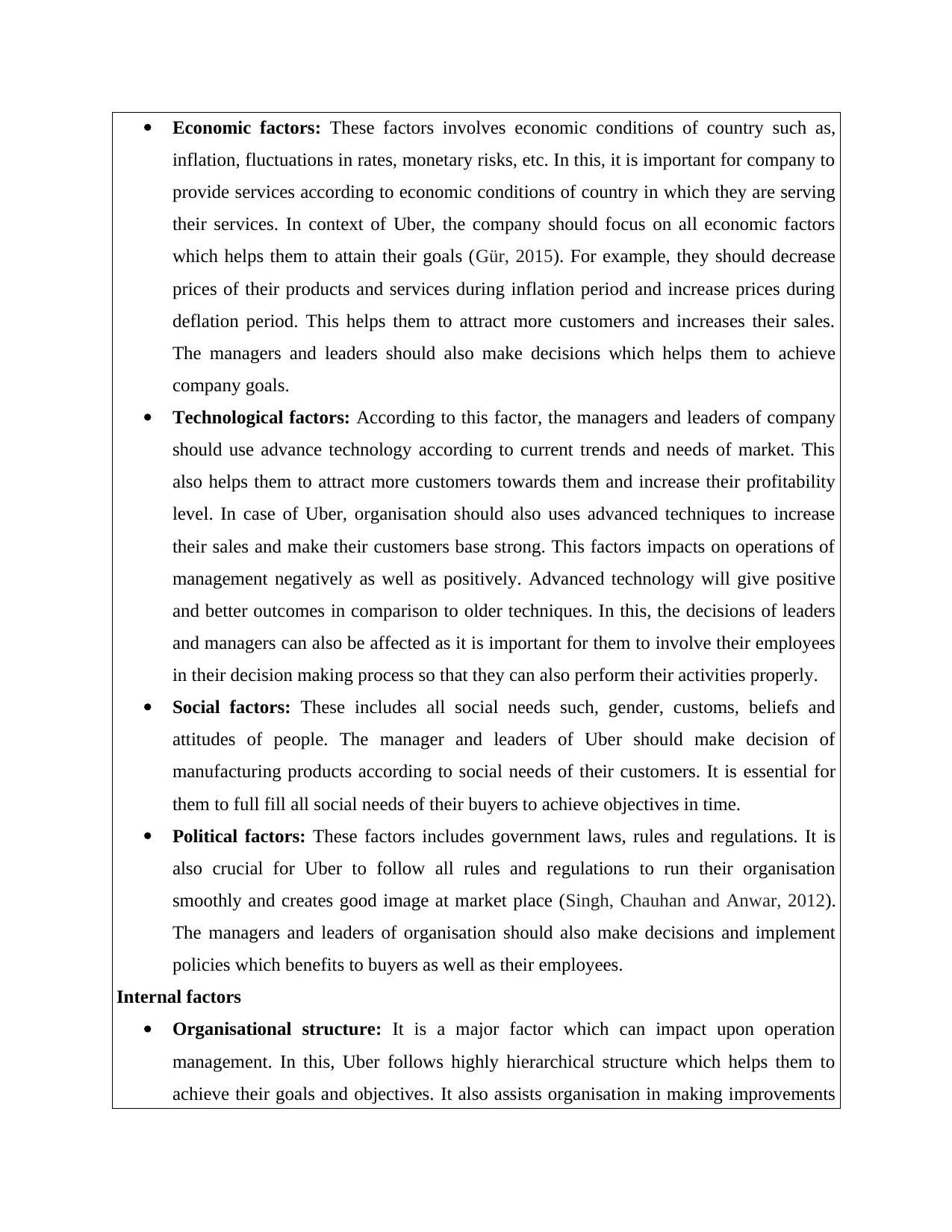
Economic factors: These factors involves economic conditions of country such as,
inflation, fluctuations in rates, monetary risks, etc. In this, it is important for company to
provide services according to economic conditions of country in which they are serving
their services. In context of Uber, the company should focus on all economic factors
which helps them to attain their goals (Gür, 2015). For example, they should decrease
prices of their products and services during inflation period and increase prices during
deflation period. This helps them to attract more customers and increases their sales.
The managers and leaders should also make decisions which helps them to achieve
company goals.
Technological factors: According to this factor, the managers and leaders of company
should use advance technology according to current trends and needs of market. This
also helps them to attract more customers towards them and increase their profitability
level. In case of Uber, organisation should also uses advanced techniques to increase
their sales and make their customers base strong. This factors impacts on operations of
management negatively as well as positively. Advanced technology will give positive
and better outcomes in comparison to older techniques. In this, the decisions of leaders
and managers can also be affected as it is important for them to involve their employees
in their decision making process so that they can also perform their activities properly.
Social factors: These includes all social needs such, gender, customs, beliefs and
attitudes of people. The manager and leaders of Uber should make decision of
manufacturing products according to social needs of their customers. It is essential for
them to full fill all social needs of their buyers to achieve objectives in time.
Political factors: These factors includes government laws, rules and regulations. It is
also crucial for Uber to follow all rules and regulations to run their organisation
smoothly and creates good image at market place (Singh, Chauhan and Anwar, 2012).
The managers and leaders of organisation should also make decisions and implement
policies which benefits to buyers as well as their employees.
Internal factors
Organisational structure: It is a major factor which can impact upon operation
management. In this, Uber follows highly hierarchical structure which helps them to
achieve their goals and objectives. It also assists organisation in making improvements
inflation, fluctuations in rates, monetary risks, etc. In this, it is important for company to
provide services according to economic conditions of country in which they are serving
their services. In context of Uber, the company should focus on all economic factors
which helps them to attain their goals (Gür, 2015). For example, they should decrease
prices of their products and services during inflation period and increase prices during
deflation period. This helps them to attract more customers and increases their sales.
The managers and leaders should also make decisions which helps them to achieve
company goals.
Technological factors: According to this factor, the managers and leaders of company
should use advance technology according to current trends and needs of market. This
also helps them to attract more customers towards them and increase their profitability
level. In case of Uber, organisation should also uses advanced techniques to increase
their sales and make their customers base strong. This factors impacts on operations of
management negatively as well as positively. Advanced technology will give positive
and better outcomes in comparison to older techniques. In this, the decisions of leaders
and managers can also be affected as it is important for them to involve their employees
in their decision making process so that they can also perform their activities properly.
Social factors: These includes all social needs such, gender, customs, beliefs and
attitudes of people. The manager and leaders of Uber should make decision of
manufacturing products according to social needs of their customers. It is essential for
them to full fill all social needs of their buyers to achieve objectives in time.
Political factors: These factors includes government laws, rules and regulations. It is
also crucial for Uber to follow all rules and regulations to run their organisation
smoothly and creates good image at market place (Singh, Chauhan and Anwar, 2012).
The managers and leaders of organisation should also make decisions and implement
policies which benefits to buyers as well as their employees.
Internal factors
Organisational structure: It is a major factor which can impact upon operation
management. In this, Uber follows highly hierarchical structure which helps them to
achieve their goals and objectives. It also assists organisation in making improvements
Paraphrase This Document
Need a fresh take? Get an instant paraphrase of this document with our AI Paraphraser
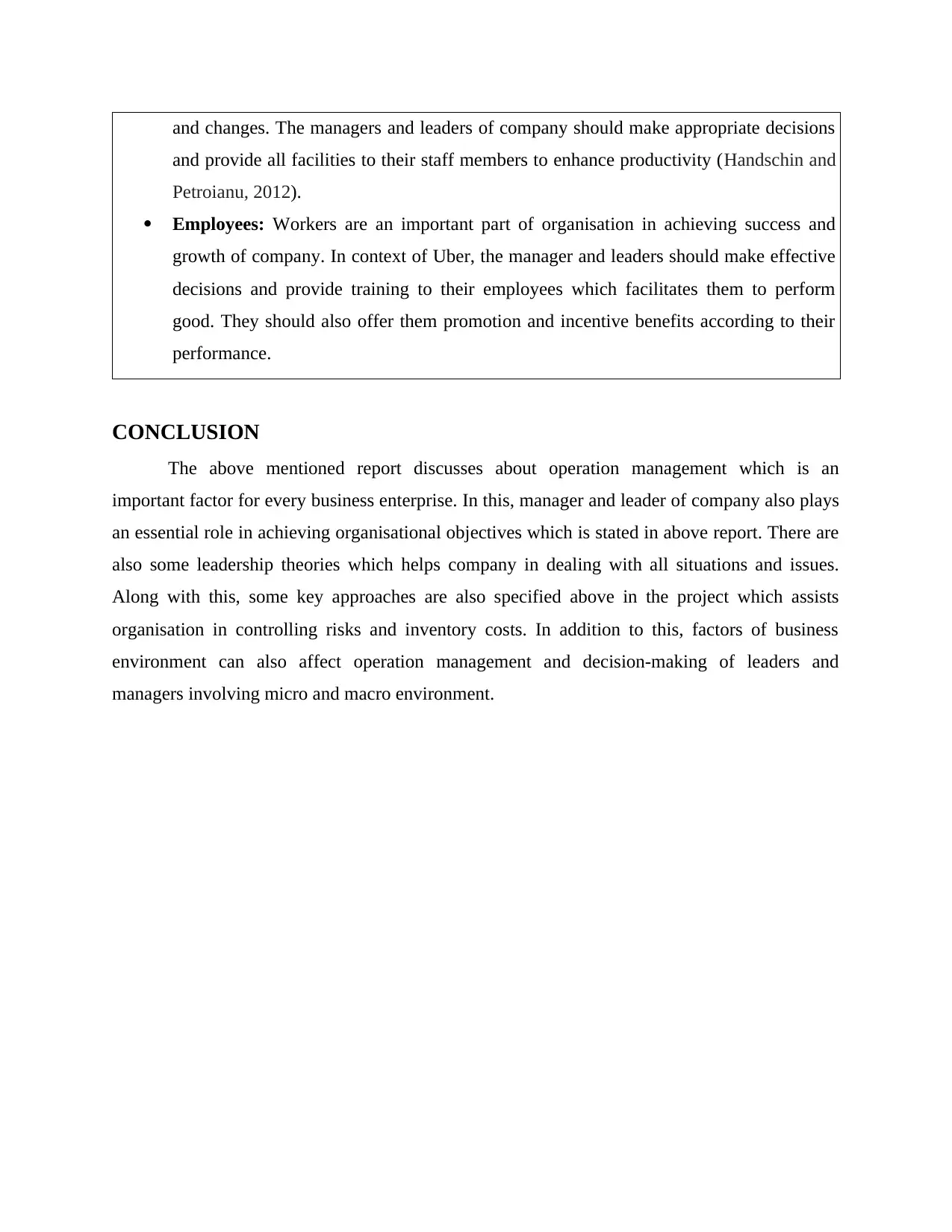
and changes. The managers and leaders of company should make appropriate decisions
and provide all facilities to their staff members to enhance productivity (Handschin and
Petroianu, 2012).
Employees: Workers are an important part of organisation in achieving success and
growth of company. In context of Uber, the manager and leaders should make effective
decisions and provide training to their employees which facilitates them to perform
good. They should also offer them promotion and incentive benefits according to their
performance.
CONCLUSION
The above mentioned report discusses about operation management which is an
important factor for every business enterprise. In this, manager and leader of company also plays
an essential role in achieving organisational objectives which is stated in above report. There are
also some leadership theories which helps company in dealing with all situations and issues.
Along with this, some key approaches are also specified above in the project which assists
organisation in controlling risks and inventory costs. In addition to this, factors of business
environment can also affect operation management and decision-making of leaders and
managers involving micro and macro environment.
and provide all facilities to their staff members to enhance productivity (Handschin and
Petroianu, 2012).
Employees: Workers are an important part of organisation in achieving success and
growth of company. In context of Uber, the manager and leaders should make effective
decisions and provide training to their employees which facilitates them to perform
good. They should also offer them promotion and incentive benefits according to their
performance.
CONCLUSION
The above mentioned report discusses about operation management which is an
important factor for every business enterprise. In this, manager and leader of company also plays
an essential role in achieving organisational objectives which is stated in above report. There are
also some leadership theories which helps company in dealing with all situations and issues.
Along with this, some key approaches are also specified above in the project which assists
organisation in controlling risks and inventory costs. In addition to this, factors of business
environment can also affect operation management and decision-making of leaders and
managers involving micro and macro environment.
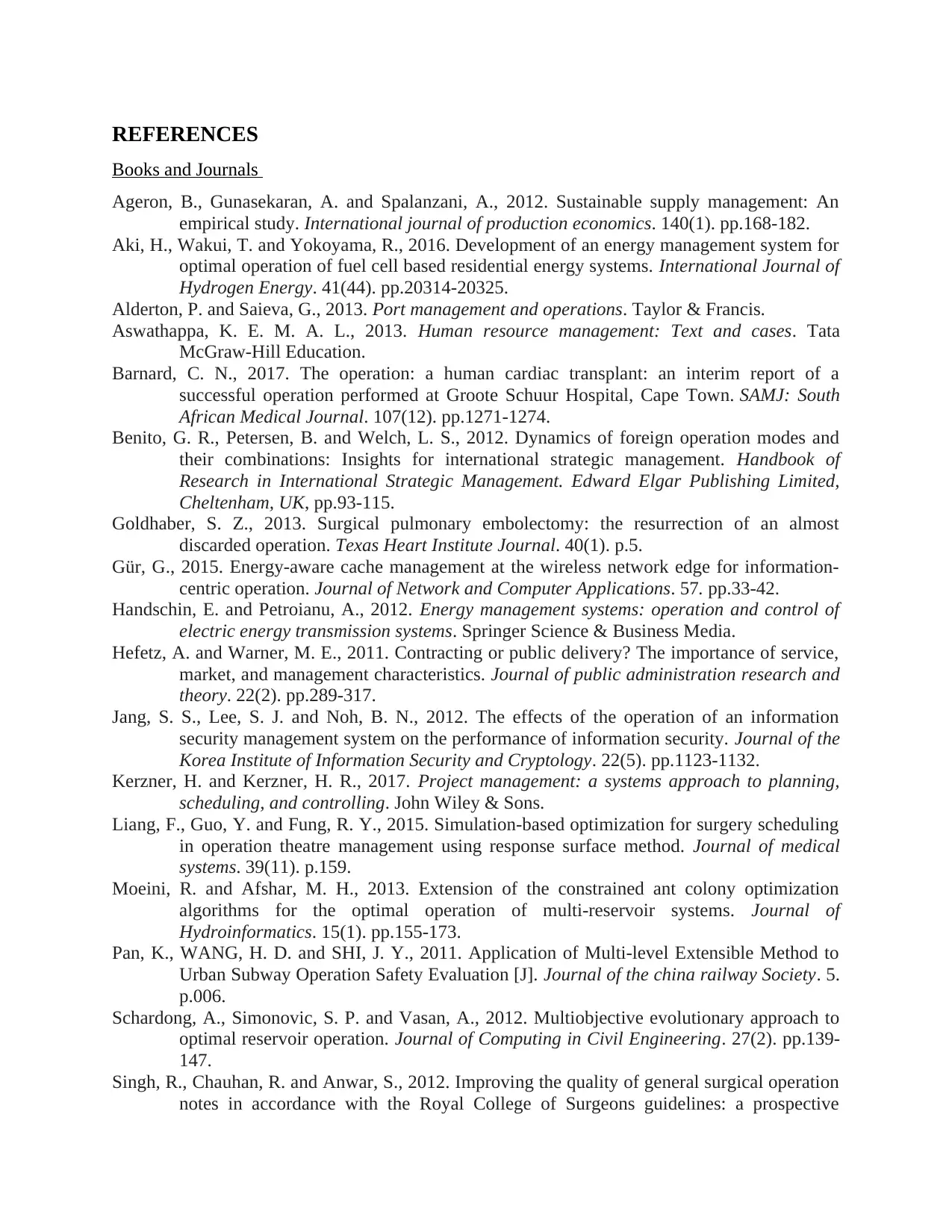
REFERENCES
Books and Journals
Ageron, B., Gunasekaran, A. and Spalanzani, A., 2012. Sustainable supply management: An
empirical study. International journal of production economics. 140(1). pp.168-182.
Aki, H., Wakui, T. and Yokoyama, R., 2016. Development of an energy management system for
optimal operation of fuel cell based residential energy systems. International Journal of
Hydrogen Energy. 41(44). pp.20314-20325.
Alderton, P. and Saieva, G., 2013. Port management and operations. Taylor & Francis.
Aswathappa, K. E. M. A. L., 2013. Human resource management: Text and cases. Tata
McGraw-Hill Education.
Barnard, C. N., 2017. The operation: a human cardiac transplant: an interim report of a
successful operation performed at Groote Schuur Hospital, Cape Town. SAMJ: South
African Medical Journal. 107(12). pp.1271-1274.
Benito, G. R., Petersen, B. and Welch, L. S., 2012. Dynamics of foreign operation modes and
their combinations: Insights for international strategic management. Handbook of
Research in International Strategic Management. Edward Elgar Publishing Limited,
Cheltenham, UK, pp.93-115.
Goldhaber, S. Z., 2013. Surgical pulmonary embolectomy: the resurrection of an almost
discarded operation. Texas Heart Institute Journal. 40(1). p.5.
Gür, G., 2015. Energy-aware cache management at the wireless network edge for information-
centric operation. Journal of Network and Computer Applications. 57. pp.33-42.
Handschin, E. and Petroianu, A., 2012. Energy management systems: operation and control of
electric energy transmission systems. Springer Science & Business Media.
Hefetz, A. and Warner, M. E., 2011. Contracting or public delivery? The importance of service,
market, and management characteristics. Journal of public administration research and
theory. 22(2). pp.289-317.
Jang, S. S., Lee, S. J. and Noh, B. N., 2012. The effects of the operation of an information
security management system on the performance of information security. Journal of the
Korea Institute of Information Security and Cryptology. 22(5). pp.1123-1132.
Kerzner, H. and Kerzner, H. R., 2017. Project management: a systems approach to planning,
scheduling, and controlling. John Wiley & Sons.
Liang, F., Guo, Y. and Fung, R. Y., 2015. Simulation-based optimization for surgery scheduling
in operation theatre management using response surface method. Journal of medical
systems. 39(11). p.159.
Moeini, R. and Afshar, M. H., 2013. Extension of the constrained ant colony optimization
algorithms for the optimal operation of multi-reservoir systems. Journal of
Hydroinformatics. 15(1). pp.155-173.
Pan, K., WANG, H. D. and SHI, J. Y., 2011. Application of Multi-level Extensible Method to
Urban Subway Operation Safety Evaluation [J]. Journal of the china railway Society. 5.
p.006.
Schardong, A., Simonovic, S. P. and Vasan, A., 2012. Multiobjective evolutionary approach to
optimal reservoir operation. Journal of Computing in Civil Engineering. 27(2). pp.139-
147.
Singh, R., Chauhan, R. and Anwar, S., 2012. Improving the quality of general surgical operation
notes in accordance with the Royal College of Surgeons guidelines: a prospective
Books and Journals
Ageron, B., Gunasekaran, A. and Spalanzani, A., 2012. Sustainable supply management: An
empirical study. International journal of production economics. 140(1). pp.168-182.
Aki, H., Wakui, T. and Yokoyama, R., 2016. Development of an energy management system for
optimal operation of fuel cell based residential energy systems. International Journal of
Hydrogen Energy. 41(44). pp.20314-20325.
Alderton, P. and Saieva, G., 2013. Port management and operations. Taylor & Francis.
Aswathappa, K. E. M. A. L., 2013. Human resource management: Text and cases. Tata
McGraw-Hill Education.
Barnard, C. N., 2017. The operation: a human cardiac transplant: an interim report of a
successful operation performed at Groote Schuur Hospital, Cape Town. SAMJ: South
African Medical Journal. 107(12). pp.1271-1274.
Benito, G. R., Petersen, B. and Welch, L. S., 2012. Dynamics of foreign operation modes and
their combinations: Insights for international strategic management. Handbook of
Research in International Strategic Management. Edward Elgar Publishing Limited,
Cheltenham, UK, pp.93-115.
Goldhaber, S. Z., 2013. Surgical pulmonary embolectomy: the resurrection of an almost
discarded operation. Texas Heart Institute Journal. 40(1). p.5.
Gür, G., 2015. Energy-aware cache management at the wireless network edge for information-
centric operation. Journal of Network and Computer Applications. 57. pp.33-42.
Handschin, E. and Petroianu, A., 2012. Energy management systems: operation and control of
electric energy transmission systems. Springer Science & Business Media.
Hefetz, A. and Warner, M. E., 2011. Contracting or public delivery? The importance of service,
market, and management characteristics. Journal of public administration research and
theory. 22(2). pp.289-317.
Jang, S. S., Lee, S. J. and Noh, B. N., 2012. The effects of the operation of an information
security management system on the performance of information security. Journal of the
Korea Institute of Information Security and Cryptology. 22(5). pp.1123-1132.
Kerzner, H. and Kerzner, H. R., 2017. Project management: a systems approach to planning,
scheduling, and controlling. John Wiley & Sons.
Liang, F., Guo, Y. and Fung, R. Y., 2015. Simulation-based optimization for surgery scheduling
in operation theatre management using response surface method. Journal of medical
systems. 39(11). p.159.
Moeini, R. and Afshar, M. H., 2013. Extension of the constrained ant colony optimization
algorithms for the optimal operation of multi-reservoir systems. Journal of
Hydroinformatics. 15(1). pp.155-173.
Pan, K., WANG, H. D. and SHI, J. Y., 2011. Application of Multi-level Extensible Method to
Urban Subway Operation Safety Evaluation [J]. Journal of the china railway Society. 5.
p.006.
Schardong, A., Simonovic, S. P. and Vasan, A., 2012. Multiobjective evolutionary approach to
optimal reservoir operation. Journal of Computing in Civil Engineering. 27(2). pp.139-
147.
Singh, R., Chauhan, R. and Anwar, S., 2012. Improving the quality of general surgical operation
notes in accordance with the Royal College of Surgeons guidelines: a prospective
⊘ This is a preview!⊘
Do you want full access?
Subscribe today to unlock all pages.

Trusted by 1+ million students worldwide
1 out of 13
Related Documents
Your All-in-One AI-Powered Toolkit for Academic Success.
+13062052269
info@desklib.com
Available 24*7 on WhatsApp / Email
![[object Object]](/_next/static/media/star-bottom.7253800d.svg)
Unlock your academic potential
Copyright © 2020–2025 A2Z Services. All Rights Reserved. Developed and managed by ZUCOL.




